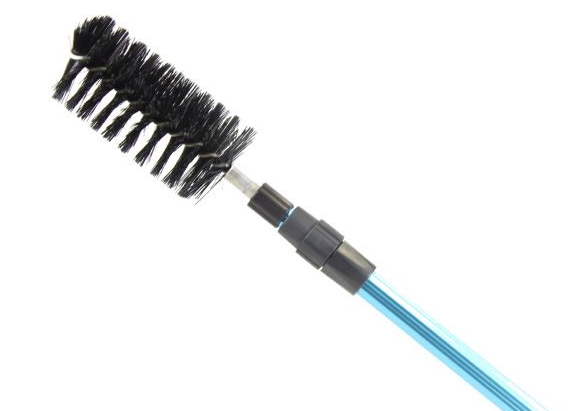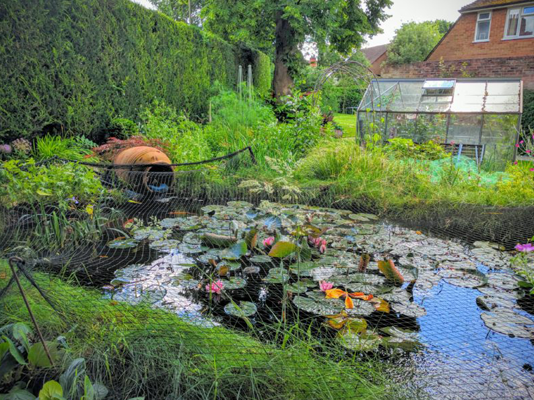How to clean a pond without draining it
A pond clean is an unenviable task, but it needs doing. If you don’t clean a pond it will fill up with leaves and debris, and pond plants and algae may overgrow. Sediment filled ponds suffer from low oxygen levels and if dirt gets disturbed nuisance algae will be fuelled.
The temptation is to strip the pond completely, but stripping it will do more harm than good. Use the right tools and you’ll be able to clean a pond without draining it, removing dirt but leaving all the beneficial stuff intact.
How to remove floating leaves from a garden pond
Floating leaves from deciduous trees should be removed with a pond skimmer net and composted. If you want to prevent leaves entering the water altogether, use a pond cover net. No leaves mean less physical waste and less pollution. Rotting leaves are unsightly and smelly, and although they are part and parcel of a natural pond, they have no benefit in an ornamental fish pond. If you don’t want leaves, a cover net or effort fit a Pond skimmer, which will suck in and trap leaves on the water surface for you on a continuous basis.
How to clean pond algae
If your water is green you don’t need to drain the garden pond either. If you don’t change what caused the green pond water, a strip and refill will result in exactly the same problem within weeks of pond cleaning and being refilled. For green water eradication, you just need a pump, filter and Ultra Violet Clarifier (UVC). The pump pumps green water to the UVC, the UVC zaps it with ultraviolet light, and the filter catches the dead green algae cells. Match the right size model to your pond and you can say goodbye to green water forever. For small ponds or a water feature, algaecides can also be used.
How to remove Blanketweed from a pond
Blanketweed algae growth is the scourge of almost every pond and needs to be physically removed as much as possible before treatment. Use a blanket weed brush (looks like a toilet brush on a long handle,) to twist the long strands around and around the brush before pulling the bulk of the weed from the pond. Long masses can be cut away with pond scissors before being pulled out and composted.
Again, a complete strip-down or even a water change is not the solution to a blanket weed problem, and instead kill off the weed first with a blanketweed treatment then clear up what's left with a sludge control. Think about shading the pond long term with water lilies and other floating plants to help prevent algae blooms, or if you can’t use aquatic plants, use a garden sail.

Use a pond hoover to vacuum a pond
Dirt and debris is a major cause of nuisance algae and should be removed. Use a pond vac to hoover the pond liner, leaving a clean pond bottom. Pond vacs only remove some pond water while pond cleaning, or water can be returned to the pond while the debris is caught in a net bag. Using an electronic pond vac is the most civilised way to carry out a large scale water garden or small pond clean as it's just like hoovering your living carpet. Just be careful when hoovering wildlife ponds. You never know what aquatic life you might suck up! Fit a mesh bag to the dirty water exit hose of the hoover.
Use a pond filter to clean pond water
A combination of regular vacuuming, blanketweed removal and solids handling pump and filter will keep the pond clear of debris and prevent a build-up, so you’ll never have to empty the garden pond to clean it out. Little and often is best so that nothing becomes too big a job, and the biological balance of the pond is maintained.
If you have to remove some pond water ensure that tap water from a garden hose is always dechlorinated before topping up and add some beneficial bacteria after any filter maintenance. This is because untreated tap water or filter media replacement can cause a loss of beneficial bacteria. Rain water can be used to top up a wildlife pond with no fish.
Convert a pond to gravity fed filtration
If you are ever lucky enough to plan a second fish pond, you may want to build it like the experts do. Gravity-fed Koi ponds differ in their filtration methods in that the inlet and outlet are built into the pond base and walls, and the filter large filter is sunk into the ground, with its top at water level. A gravity-fed koi pond uses a combination of a bottom drain, wide, 4” pipe and a built-in surface skimmer to always keep the pond free of floating and sunken debris.
Once removed from the pond the water is first prefiltered by a vortex, bead filter, sieve or drum filter before being separately biologically filtered afterwards. Sieves and drums mean leaves and large debris can be caught and flushed to waste before being broken down, and clever design enables the filter to be drained and cleaned without draining the main pond. Prefilters can even have automatic cleaning for true hands-off pond maintenance and more time to enjoy the garden pond.
Pond water temperature matters!
If its a fish pond, don't clean the pond or disturb the fish if the water temperature is at 4 degrees Celsius or below. Fish hibernate in garden ponds at that temperature so wait until warmer weather. You'll freeze while doing it too!









